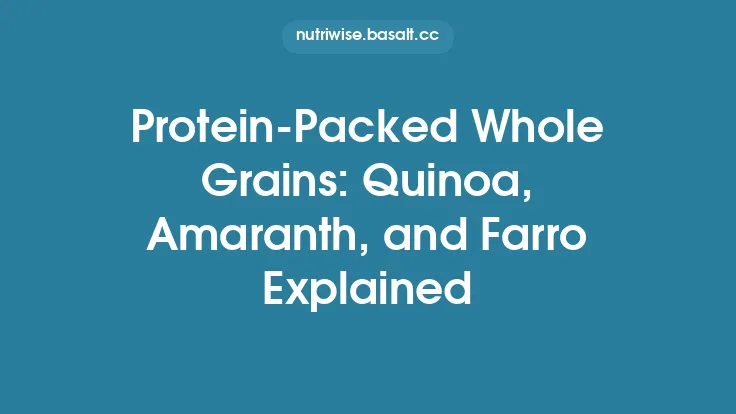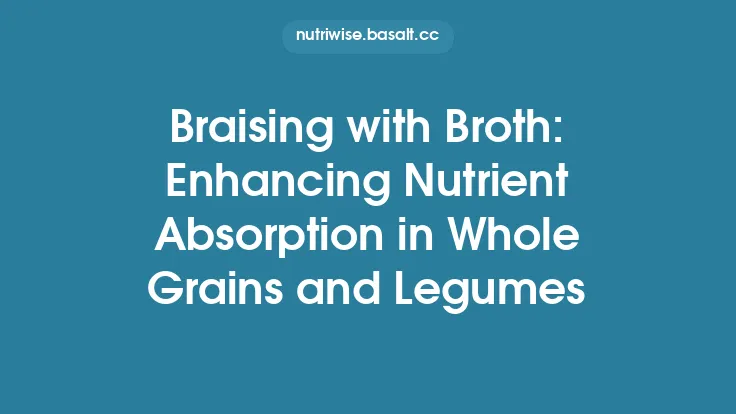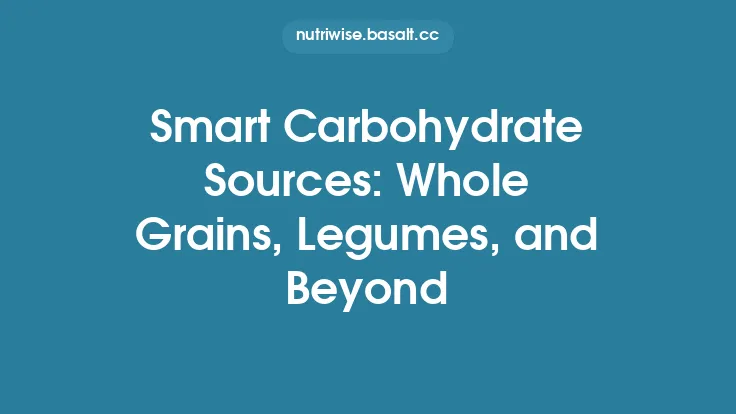Alternative grains such as buckwheat, quinoa, and amaranth have moved from the periphery of the pantry to the center of many allergy‑ and intolerance‑friendly kitchens. Their naturally gluten‑free status, combined with a robust nutrient profile, makes them ideal building blocks for meals that accommodate a wide range of dietary restrictions without sacrificing flavor or texture. This article explores the science behind these grains, offers practical guidance on selection, storage, and preparation, and provides a curated set of recipes that showcase their versatility across breakfast, lunch, dinner, and side‑dish applications.
Understanding Alternative Grains: Buckwheat, Quinoa, and Amaranth
Buckwheat (Fagopyrum esculentum) is not a true cereal grain but a pseudocereal related to rhubarb and sorrel. Its triangular seeds, often called “groats,” have a mildly earthy flavor and a firm bite when cooked.
Quinoa (Chenopodium quinoa) belongs to the same family as spinach and beets. The seed’s delicate, slightly nutty taste and fluffy texture after cooking have made it a staple in health‑focused cooking.
Amaranth (Amaranthus spp.) is another pseudocereal whose tiny seeds expand dramatically when simmered, creating a creamy, porridge‑like consistency. Its flavor is subtly sweet with a hint of nuttiness.
All three are naturally free of gluten, dairy, soy, and most common allergens, making them safe choices for individuals with celiac disease, lactose intolerance, soy allergy, or egg sensitivity. Their distinct textures, however, mean each grain requires specific handling to achieve optimal results.
Nutritional Profiles and Allergy Considerations
| Grain | Calories (per 100 g, cooked) | Protein | Fiber | Key Micronutrients | Common Allergen Triggers |
|---|---|---|---|---|---|
| Buckwheat | 92 | 3.4 g | 2.7 g | Magnesium, manganese, copper, B‑vitamins | Rarely triggers allergies; may contain trace gluten from cross‑contamination |
| Quinoa | 120 | 4.4 g | 2.8 g | Iron, potassium, folate, zinc | Saponin coating can cause mild gastrointestinal irritation if not rinsed |
| Amaranth | 102 | 3.8 g | 2.1 g | Calcium, iron, magnesium, lysine (essential amino acid) | Generally hypoallergenic; may be processed with shared equipment |
The protein quality of these grains is noteworthy. Quinoa and amaranth contain all nine essential amino acids, a rarity among plant foods, while buckwheat is especially rich in lysine. For those avoiding animal‑derived proteins, these grains can help meet daily protein requirements when paired with legumes or nuts (the latter can be omitted or substituted for allergy‑friendly alternatives).
Selecting High‑Quality Grains and Storage Tips
- Inspect the Package – Look for grains that are uniformly colored, free of clumps, and stored in airtight packaging. For quinoa, a “pre‑rinsed” label indicates that most saponins have already been removed.
- Check for Freshness – A faint, nutty aroma signals freshness. Stale grains may develop off‑flavors and lose nutritional potency.
- Storage Conditions –
- Buckwheat: Store in a cool, dark pantry for up to 6 months. For longer shelf life, keep in the freezer.
- Quinoa: Because of its higher oil content, quinoa benefits from refrigeration (up to 12 months) or freezing in sealed containers.
- Amaranth: Similar to quinoa, amaranth should be kept in the refrigerator or freezer to prevent rancidity.
Label the containers with the purchase date to rotate stock efficiently.
Preparing Buckwheat: Techniques and Tips
- Rinsing – Place groats in a fine‑mesh sieve and rinse under cold water to remove dust.
- Toasting (Optional) – For a deeper, nuttier flavor, toast rinsed groats in a dry skillet over medium heat for 3–5 minutes, stirring constantly.
- Cooking Ratio – Use a 1:2.5 (buckwheat:water) ratio for whole groats.
- Method – Bring water to a boil, add buckwheat, reduce to a simmer, cover, and cook for 12–15 minutes until tender but still slightly al dente.
- Resting – Remove from heat and let sit, covered, for 5 minutes. Fluff with a fork before serving.
For a quicker alternative, “quick‑cooking” buckwheat (pre‑steamed and rolled) requires a 1:2 ratio and a 5‑minute simmer.
Quinoa Mastery: Rinsing, Toasting, and Cooking Methods
- Rinsing – Place quinoa in a bowl, cover with water, swirl, and discard the water. Repeat 2–3 times to eliminate saponins, which can impart bitterness.
- Toasting – Heat a tablespoon of oil in a saucepan, add rinsed quinoa, and toast for 2–3 minutes until fragrant. This step is optional but adds complexity.
- Cooking Ratio – Standard ratio is 1:2 (quinoa:water or broth).
- Cooking – Bring liquid to a boil, add quinoa, reduce to a low simmer, cover, and cook for 15 minutes.
- Steam Finish – After cooking, remove from heat and let stand, covered, for 5 minutes. Fluff with a fork.
For a creamier texture, increase the liquid to a 1:2.5 ratio and simmer for 20 minutes, stirring occasionally.
Amaranth Basics: From Porridge to Polenta‑Style Dishes
- Rinsing – Briefly rinse under cold water; amaranth’s small size makes thorough rinsing less critical.
- Cooking Ratio – Use a 1:3 (amaranth:liquid) ratio for porridge; for a firmer, polenta‑like consistency, use 1:2.5.
- Method – Bring liquid (water, broth, or plant‑based milk) to a boil, stir in amaranth, reduce to low heat, and simmer, stirring frequently to prevent clumping.
- Timing – Porridge: 20–25 minutes; Polenta‑style: 30–35 minutes, until the mixture thickens and pulls away from the sides of the pan.
- Flavor Enhancements – Add a pinch of salt, a splash of olive oil, or a dash of nutritional yeast for umami without dairy.
Because amaranth thickens quickly, keep a close eye on the pot and adjust liquid as needed.
Building Balanced Meals with Alternative Grains
- Protein Pairings – Combine grains with legumes (e.g., lentils, chickpeas), tofu, tempeh, or lean animal proteins for a complete amino acid profile.
- Vegetable Integration – Roast, steam, or sauté a colorful array of vegetables to add fiber, vitamins, and antioxidants.
- Healthy Fats – Drizzle with extra‑virgin olive oil, avocado oil, or incorporate nuts/seeds (if tolerated) for satiety and flavor.
- Seasoning Strategies – Use fresh herbs, citrus zest, and spices (cumin, smoked paprika, turmeric) to create depth without relying on common allergens like soy sauce or dairy‑based sauces.
A well‑balanced plate typically follows a 1:1:1 ratio of grain, protein, and vegetables, with a modest amount of healthy fat.
Recipe Collection
Buckwheat Savory Pancakes (Gluten‑Free, Egg‑Free)
Ingredients
- 1 cup buckwheat flour
- ½ cup oat flour (certified gluten‑free)
- 1 tsp baking powder (aluminum‑free)
- ¼ tsp salt
- 1 cup unsweetened almond‑milk alternative (or oat milk)
- 2 Tbsp melted coconut oil
- 1 Tbsp ground flaxseed + 3 Tbsp water (flax “egg”)
- ½ cup finely grated zucchini, squeezed dry
- 2 Tbsp chopped chives
Method
- Whisk flaxseed and water; let sit 5 minutes to thicken.
- In a bowl, combine dry ingredients.
- Add wet ingredients, including the flax “egg,” and stir until smooth.
- Fold in zucchini and chives.
- Heat a non‑stick skillet over medium heat; lightly oil.
- Pour ¼‑cup batter per pancake; cook 2‑3 minutes per side until golden.
*Serve with a dollop of dairy‑free yogurt and a drizzle of maple syrup for a sweet‑savory twist.*
Quinoa Power Bowl with Roasted Vegetables
Ingredients
- 1 cup quinoa, rinsed
- 2 cups low‑sodium vegetable broth
- 1 cup cubed sweet potato
- 1 cup cauliflower florets
- 1 Tbsp olive oil
- ½ tsp smoked paprika
- ½ tsp ground cumin
- ¼ tsp black pepper
- ½ avocado, sliced
- 2 Tbsp toasted pumpkin seeds (optional, omit if seed‑allergic)
- Dressing: 2 Tbsp tahini, 1 Tbsp lemon juice, 1 tsp maple syrup, water to thin
Method
- Preheat oven to 200 °C (400 °F). Toss sweet potato and cauliflower with oil, paprika, cumin, and pepper; roast 20‑25 minutes, turning halfway.
- Meanwhile, bring broth to boil, add quinoa, reduce to simmer, cover, and cook 15 minutes. Fluff.
- Assemble bowls: quinoa base, roasted vegetables, avocado, pumpkin seeds, and drizzle dressing.
Amaranth Breakfast Porridge with Fruit Compote
Ingredients
- ½ cup amaranth
- 1 ½ cup unsweetened oat milk
- Pinch of salt
- 1 Tbsp chia seeds (optional)
- 1 Tbsp maple syrup (adjust to taste)
- Compote: 1 cup mixed berries (fresh or frozen), 1 Tbsp honey, ½ tsp vanilla extract
Method
- In a saucepan, combine amaranth, oat milk, and salt. Bring to a gentle boil, then reduce heat and simmer, stirring frequently, for 20‑25 minutes until thick and creamy.
- Stir in chia seeds and maple syrup; let sit 5 minutes.
- For compote, simmer berries, honey, and vanilla over low heat until the mixture thickens, about 8 minutes.
- Serve porridge topped with warm compote and a sprinkle of cinnamon.
Buckwheat Tabouleh (Nut‑Free, Soy‑Free)
Ingredients
- 1 cup whole buckwheat groats, toasted
- 2 cups boiling water, poured over groats; cover and let sit 15 minutes, then fluff
- 1 cup finely diced cucumber
- 1 cup halved cherry tomatoes
- ½ cup chopped fresh parsley
- ¼ cup chopped fresh mint
- ¼ cup lemon juice
- 3 Tbsp extra‑virgin olive oil
- Salt and pepper to taste
Method
- Prepare buckwheat as described; allow to cool to room temperature.
- In a large bowl, combine cooled buckwheat, cucumber, tomatoes, parsley, and mint.
- Whisk lemon juice, olive oil, salt, and pepper; pour over salad and toss gently.
Quinoa‑Amaranth Pilaf with Herbs
Ingredients
- ½ cup quinoa, rinsed
- ½ cup amaranth
- 3 cups low‑sodium vegetable broth
- 1 Tbsp olive oil
- 1 small onion, finely chopped
- 2 garlic cloves, minced
- 1 tsp dried thyme
- 1 tsp dried oregano
- ¼ cup chopped fresh cilantro
- Salt to taste
Method
- Heat oil in a pot; sauté onion and garlic until translucent.
- Add quinoa, amaranth, thyme, and oregano; toast 2 minutes.
- Pour broth, bring to a boil, then reduce to low heat, cover, and simmer 20 minutes until liquid is absorbed.
- Remove from heat, let stand 5 minutes, then fluff and stir in cilantro.
Amaranth‑Crusted Fish Fillet (Dairy‑Free)
Ingredients
- 4 white‑fish fillets (e.g., cod, tilapia)
- ½ cup amaranth, finely ground in a food processor
- ¼ cup gluten‑free breadcrumbs (optional)
- 1 tsp paprika
- ½ tsp garlic powder
- Salt and pepper
- 2 Tbsp olive oil for pan‑frying
Method
- Pat fish dry; season with salt and pepper.
- Mix ground amaranth, breadcrumbs (if using), paprika, and garlic powder on a plate.
- Dredge each fillet in the mixture, pressing gently to adhere.
- Heat oil in a skillet over medium‑high heat; cook fillets 3‑4 minutes per side until golden and cooked through.
*Serve with a squeeze of lemon and a side of steamed greens.*
Adapting Traditional Recipes to Alternative Grains
- Pasta Substitutes – Use cooked quinoa or buckwheat “noodles” (soba, which is 100 % buckwheat) in place of wheat pasta for gluten‑free Italian dishes.
- Bread Alternatives – Combine buckwheat flour with psyllium husk and baking soda to create quick flatbreads or crackers.
- Dessert Bases – Amaranth can replace rice in rice‑pudding‑style desserts; sweeten with fruit purées and a touch of coconut cream for richness without dairy.
When converting a recipe, maintain the original liquid‑to‑grain ratio for the chosen grain, and adjust cooking time based on the grain’s texture requirements.
Meal Planning Strategies for Allergy‑Sensitive Diets
- Batch‑Cook Grains – Prepare a large pot of each grain at the start of the week; portion into airtight containers for quick assembly.
- Label for Safety – Clearly mark containers with the grain type and any added seasonings to avoid cross‑contamination.
- Create “Core” Meals – Design a rotating menu of three core dishes (e.g., buckwheat salad, quinoa bowl, amaranth porridge) that can be customized with different proteins and vegetables.
- Utilize the Freezer – Cooked quinoa and buckwheat freeze well for up to three months; portion into single‑serve bags for defrost‑and‑go meals.
- Mind Cross‑Contact – Store grains separately from common allergens (nuts, soy, dairy) and use dedicated utensils when possible.
By integrating these practices, you can maintain variety while ensuring each meal remains safe for those with specific intolerances.
Troubleshooting Common Issues
| Symptom | Likely Cause | Solution |
|---|---|---|
| Bitter taste (especially with quinoa) | Incomplete rinsing of saponins | Rinse quinoa thoroughly 3–4 times; consider pre‑rinsed brands |
| Gummy or overly sticky texture (buckwheat or amaranth) | Too much water or insufficient stirring | Adjust liquid ratio; stir amaranth frequently during cooking |
| Grain remains hard after cooking | Insufficient cooking time or low heat | Increase simmer time; ensure a gentle boil, not a rapid boil |
| Off‑flavor after storage | Rancidity from oil content | Store grains in the refrigerator or freezer; use airtight containers |
| Clumping in pilafs or salads | Over‑mixing or using hot grains in cold dishes | Allow grains to cool to room temperature before tossing with dressings |
Resources and Further Reading
- The Celiac Disease Foundation – Guidelines on cross‑contamination prevention for pseudocereals.
- Academy of Nutrition and Dietetics – Position paper on plant‑based protein completeness.
- FoodSafety.gov – Best practices for storing high‑oil grains to prevent oxidation.
- The Whole Grains Council – Technical sheets on buckwheat, quinoa, and amaranth nutrition.
These sources provide evidence‑based information that can deepen your understanding of alternative grains and support safe, enjoyable cooking for allergy‑sensitive households.
By mastering the unique characteristics of buckwheat, quinoa, and amaranth, you unlock a world of nutritious, flavorful dishes that cater to a broad spectrum of dietary needs. Whether you are planning weekly meals, experimenting with new textures, or seeking reliable, allergy‑friendly staples, these grains offer the flexibility and health benefits that make them indispensable in any modern kitchen. Happy cooking!





